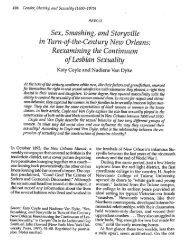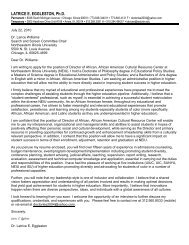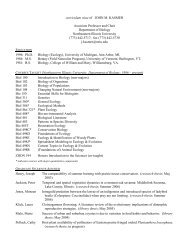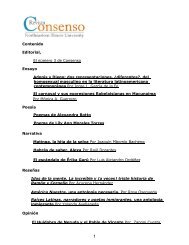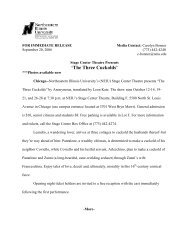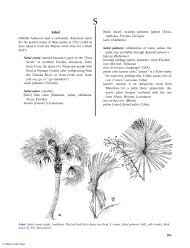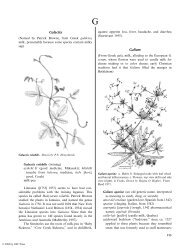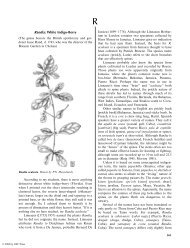Herba Cana - Northeastern Illinois University
Herba Cana - Northeastern Illinois University
Herba Cana - Northeastern Illinois University
You also want an ePaper? Increase the reach of your titles
YUMPU automatically turns print PDFs into web optimized ePapers that Google loves.
© 2004 by CRC Press<br />
530 Florida Ethnobotany<br />
kvpotoyv [’kvpotoyv, kvpolóye](kvpoteyetv, something<br />
to put on the head, Creek)<br />
[ground, wild] lemon; yellow-berry<br />
Maiapfel (May apple, German); May-apple<br />
[American, common, mayapple] (Catesby called<br />
the herbs May Apple in 1731, although the OED<br />
1971 says the name dates from Philip Miller in<br />
1733 as Pomum Maiale, May apple; either way<br />
Catesby found it in local use in the Carolinas by<br />
the 1720s); pomme de mai (May apple, Quebec)<br />
[American, wild] mandrake[-pear] (pear-like fruits,<br />
compared with Mandragora officinarum, New<br />
Jersey)<br />
mäskätámîn utcípa (mäskätá, defecation, mîn,<br />
berry, utcípa, root, Menomini); maskiíchtew<br />
[masgichteu] (maashk, defecating, kiich, causes,<br />
Delaware)<br />
maypop (a name usually applied to Passiflora,<br />
Virginia)<br />
parasols (an allusion to the leaves, Ohio); umbrella<br />
plant [root] (Virginia)<br />
podophylle (French)<br />
Puck’s foot (‘‘Puck,’’ from Old English púca, Old<br />
Norse, púki, Welsh, pwca, Irish púca, a mischievous<br />
demon; it is not clear if the word is of<br />
Teutonic or Celtic origin, but it was in English<br />
by about A.D. 1000; Middle English the pouke<br />
was identified with the devil; from the 16th<br />
century, as Puck, a tricky goblin or sprite; also<br />
called Robin Goodfellow, Hobgoblin; all three<br />
were used by Shakespeare in 1590)<br />
raccoon berry (from ärä’kun, for Procyon lotor,<br />
Virginia Algonquian; in use by 1884)<br />
vegetable-calomel (‘‘calomel,’’ from Greek calos,<br />
beautiful, melos, black or from Ethiopian calos,<br />
beautiful, melos, black, because white or pale<br />
bodies rubbed with it become black; mercurous<br />
chloride [Hg 2Cl2] ormercurius dubius; used as a<br />
laxative in medicine from 1676)<br />
vegetable-mercury (the same allusion as ‘‘calomel’’)<br />
wild jalap (‘‘jalap,’’ from xalli, sand, atl, water, pan,<br />
upon, Náhuatl, used to identify the city as<br />
Xalapa and, in this context, Ipomoea purga, by<br />
1675)<br />
When I was still a child, I was told that there were<br />
‘‘male’’ and ‘‘female’’ plants of May apples. They were<br />
easy to tell apart, because the ‘‘male’’ had a single<br />
leafstalk, and the ‘‘female’’ had a branched leafstalk<br />
with a leaf on each branch. Moreover, the ‘‘female’’<br />
had flowers in the place where the stalks split into two.<br />
I was skeptical. I planted some near my home. Each<br />
rhizome node (joint) bore a single leaf*/which was<br />
unbranched one year and branched the next. So much<br />
for male and female plants.<br />
The first record Linnaeus had of these plants was<br />
in German physician Christian Mentzel’s (1622 /1701)<br />
book of 1682, the Pinax, where he called them<br />
Aconitifolia humilis, flore albo unico campanulato,<br />
fructu cynosbati (A weak herb with leaves like<br />
Monk’s-hood, a single, bell-shaped, white flower, a<br />
fruit like a dog briar). Mark Catesby (1731 /1732)<br />
called the plants Anapodophyllum canandense (duck<br />
foot leaf from <strong>Cana</strong>da). Thankfully, Linnaeus shortened<br />
the name to Podophyllum in his Hortus Cliffortianus<br />
of 1738. Catesby added that, because the herb<br />
flowers in May, the local residents in South Carolina<br />
called it ‘‘May apple.’’<br />
Podophyllum has two species (Mabberley 1997).<br />
Podophyllum peltatum is endemic to the eastern<br />
United States and ranges from Florida to Quebec<br />
and Ontario in <strong>Cana</strong>da, and west to Minnesota and<br />
eastern Texas (Fernald 1950, Correll and Johnston<br />
1970, Diggs et al. 1999). The other species, P.<br />
hexandrum, grows from the Himalayas to eastern<br />
Asia, including Afghanistan, Pakistan, northern India,<br />
and China (Hsu 1986, Hocking 1997).<br />
Fernald et al. (1958) noted that the fruits are<br />
relished by most individuals when fresh, although<br />
Harvard guru Asa Gray (1810 /1888) was the exception.<br />
Gray wrote that the fruit was ‘‘mawkish, eaten by<br />
pigs and boys.’’ Although the taste is ‘‘peculiar,’’ as<br />
Fernald et al. (1958) described it, the flavor is agreeable.<br />
Native people in the Americas concurred. At<br />
least the Cherokee, Delaware, Iroquois, Menomini,<br />
Meskwaki, Osage, Penobscot, and Ojibwa ate the<br />
fruits fresh, cooked, or mashed and made into small<br />
cakes that were dried for future use (Hunter [1823]<br />
1973, Yanovsky 1936, Vogel 1970, King 1984, Moerman<br />
1998). As needed, the cakes were soaked in warm<br />
water, cooked as a sauce, or mixed with corn bread.<br />
There are accounts of indigenous people committing<br />
suicide by eating the root of May-apple (Vogel<br />
1970). Because the roots are purgative, emetic, and<br />
irritating, that would be an excruciating way to die,<br />
although Benjamin S. Barton wrote in 1810 that the<br />
root was ‘‘possessed of some degree of an anodyne, or<br />
narcotic quality.’’<br />
The Cherokee used Podophyllum to treat intestinal<br />
worms, rheumatism, ulcers, and sores, as a laxative,<br />
and dropped in the ears ‘‘to restore hearing’’ (Hamel<br />
and Chiltoskey 1975). The Choctaw treated biliousness<br />
with the root (Swanton 1931). The Delaware used<br />
the herb as a laxative and spring tonic (Moerman<br />
1998). The Iroquois used it as a strong physic, to treat<br />
boils, as a laxative, and as a poison to soak corn seeds<br />
in before planting. The Menomini also used it to kill<br />
insects on cultivated plants (Mahr 1955a). The Mesk-





